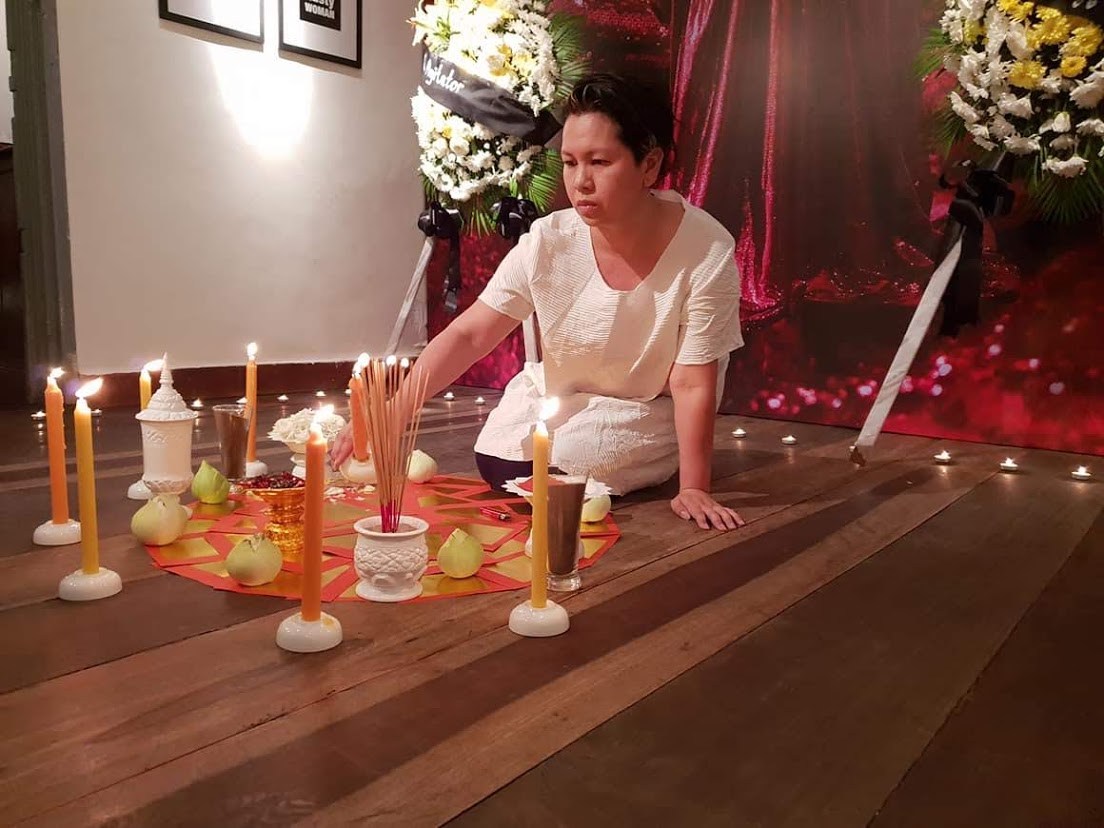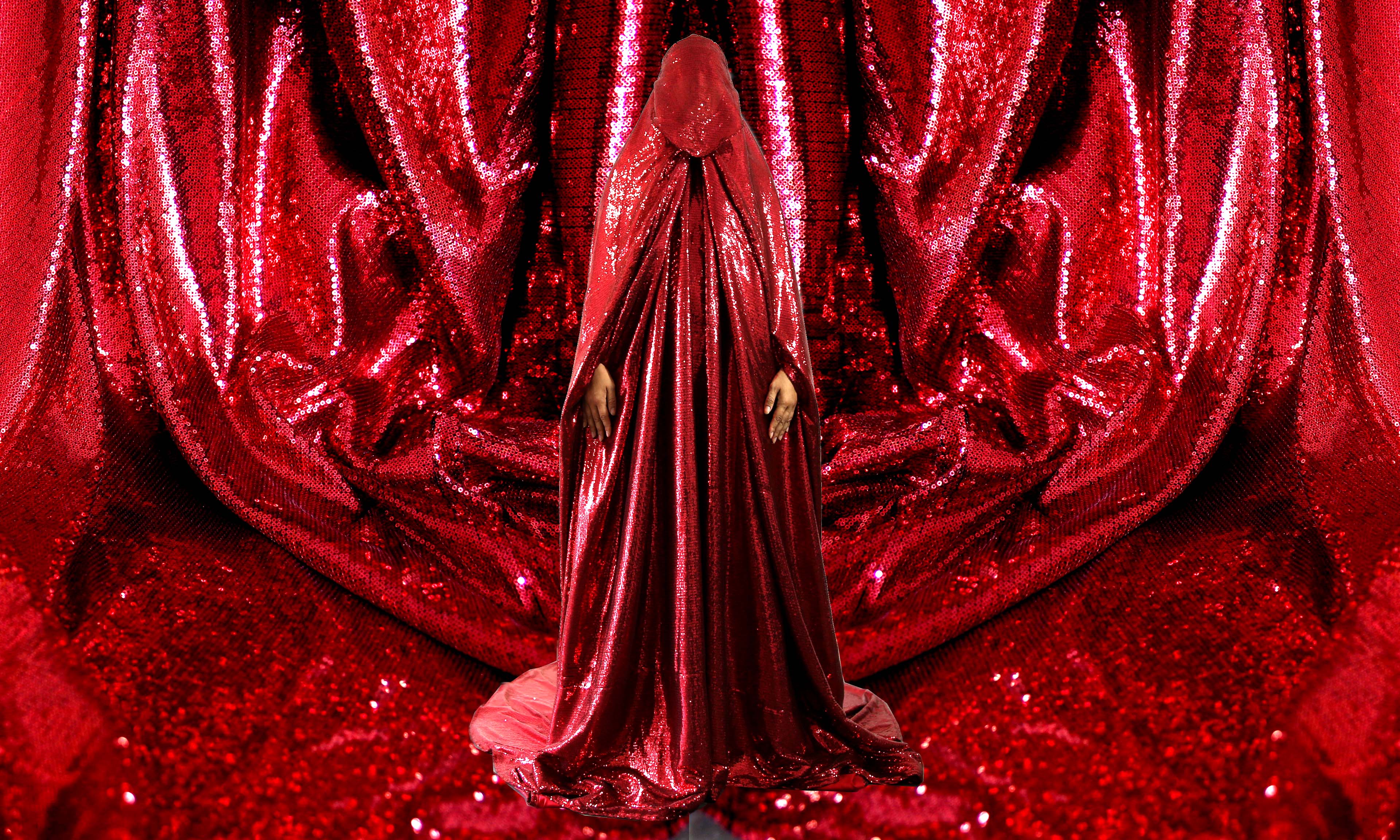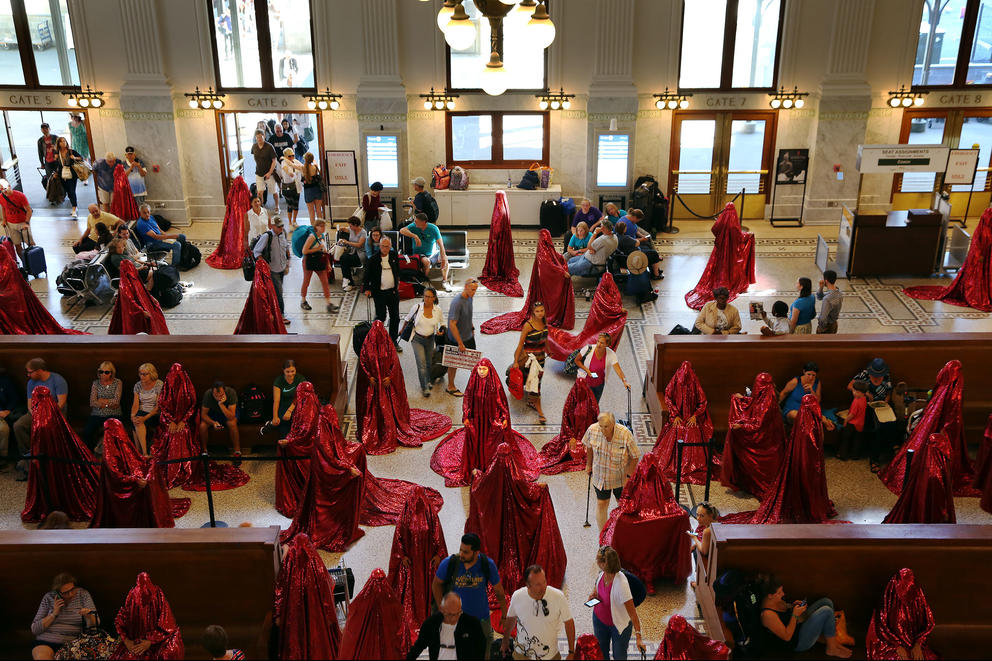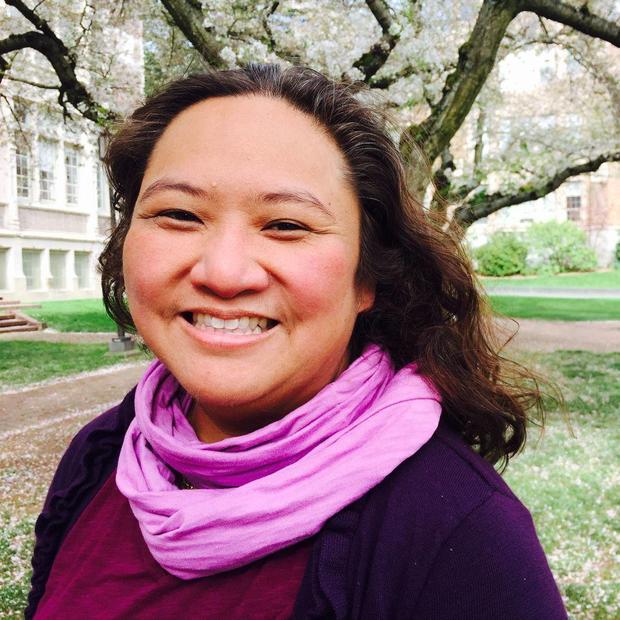Ali is mourning the disappearance of the Red Chador, a performance piece and persona that used a red sequined shimmering floor-length garment. She wore the garment in performance for almost three years throughout the world. But, in December 2017, the Red Chador garment was lost in transit from a performance in Palestine to the United States.
The loss, Ali explains, felt like yet another casualty of traveling while Muslim, telling the artist “not to come back.” After a discussion with curator Thea Quiray Tagle, Ali realized that she needed to mourn the disappearance as a death. She recently spoke with me at the Red Elm Café in Tacoma’s Hilltop neighborhood.
“The last time something this horrible happened to me,” says the artist, “I left the country.”
Ali’s performance art often explores contentious issues, including racial inequality, intolerance, displacement and Islamophobia. Over the years, her art has prompted audience reactions ranging from tears to embraces to outright hostility.
Ali first conceived of The Red Chador while in Cambodia on a Fulbright Fellowship, a year after her MFA project at the Art Institute of Chicago was publicly defaced. That project, “The 1700% Project,” was her capstone project — a site-specific series focusing on the exponential increase of hate crimes against Arabs and Muslims after Sept.11.
While traveling, Ali has been racially profiled, strip-searched and detained for hours. And as a refugee from a Cambodian family, she is no stranger to loss.
The Red Chador first appeared in Paris in April 2015, in solidarity with those affected by the Charlie Hebdo attacks and as a reaction to the portrayal of Muslims in the media. The Paris appearance was followed by other exhibitions in Hong Kong, San Francisco, Hartford, Washington D.C., Philadelphia and Seattle.
The day after the 2016 U.S. presidential election, The Red Chador stood silently at Pike Place Market, holding up a sign. “Ban me,” it read on one side; on the other: “I am a Muslim.” Nearly one year after the Pike Place Market appearance, the Red Chador reappeared in Seattle, walking through several neighborhoods to the “Borderlands” exhibit at King Street Station. “The space she held [there] was really powerful,” recalls Linda Ando, a Seattle Japanese American resident and activist who saw Ali at King Street. “[The Red Chador’s] like a Statue of Liberty, what she represents. Her intent was of peace, being confident, saying that she has the right to walk among you all.”
Ando was particularly moved at seeing the Red Chador interact with Ali’s children: “To see her kids run up to her [when she arrived at King Street], to see her embrace them with such joyous love….she’s a reminder of what we believe in. That’s why I’m drawn to her.”
The Red Chador’s garment is also a prime example of the cultural “hybridity” that Ali says she “stitches” into all of her artwork. The garment takes traditional elements of the Islamic religion, but plays with expectations and perceptions of these within a Western (and Islamophobic) context.
It includes the burka, but the chador is much longer than tradition, granting Ali a regal presence.
“I’m only 5’3”, but for some reason that dress makes me feel like I’m 12 feet,” she laughs.
The fabric is red, a marked contrast to more commonly seen black or white chadors.
“The red to me is also life and blood and passion.”
And it’s sequined.
“I knew that the fabric had to be what I call fabulous, and it was going to be something that was over the top.”
It’s also a nod to Ali’s love of science fiction — think: the red chador-wearing Imperial Guards in Star Wars. Overall, the garment subtly reflects Ali’s sense of humor. “I wanted her to be bright, noticeable, visible, and playing with ostentatiousness…[like] a really fabulous sort of gala prom dress, if an Orthodox Muslim woman was to go to a ball. [For] all of her public interventions, [it was] her constant debut.”

Whether it’s through spoken word poetry, installations or performance art, Ali’s work carries a global complexity and consciousness that can make it difficult for audiences to “read” right away. “And that’s okay with me,” she says now. “I just hope that it can lead to asking good questions.”
What do people rarely ask her about her work? Ali pauses for several long minutes, thinking. “[Rarely] do I get asked about love and compassion,” she says, finally. “I work with empathy.”
Ali has scheduled Red Chador memorial exhibitions later this year in Philadelphia and Phnom Penh. Later this month, there will be a memorial in Adelaide, Australia.
In Phnom Penh, she created a syncretic ritual that involved candles, an Islamic prayer, a newsprint obituary in Khmer and English and a burning and burying of a remnant from the garment. “The Red Chador gained prominence in the global art world for using the aesthetics of religion and patriotism to challenge social and political anxieties,” wrote journalist Diana Montaño in the obituary. Online, Ali is inviting people to reflect on their encounters with the Red Chador around the world.
This month’s memorial in Australia will expand on the Phnom Penh ceremonies, with an expanded obituary in French and Arabic in addition to Khmer and English. Printed signs, text and images from past Red Chador appearances from around the world will accompany Ali as she delivers another eulogy and performs another ritual.
Ali now muses on how these memorials have given her a way to process her grief. “I am operating from a state of shock, and numbness,” she says. “I am still in shock that Donald Trump was elected president and that millions of people support him. And similarly, I am in shock that this garment, which was so important to me, was taken. It’s not a paralyzing numbness but it’s a numbness in the sense that I don’t know what to make out of all of this.
“[But] there’s something that can be made out of this great loss. And that’s also influenced by the refugee experience of coming from nothing.”
Next year, Ali says she plans to “rebirth” the Red Chador, stronger and even more joyous than before. “Because the work was disrupted she has to come back,” she says, “but in solidarity with other issues that are going on.”





